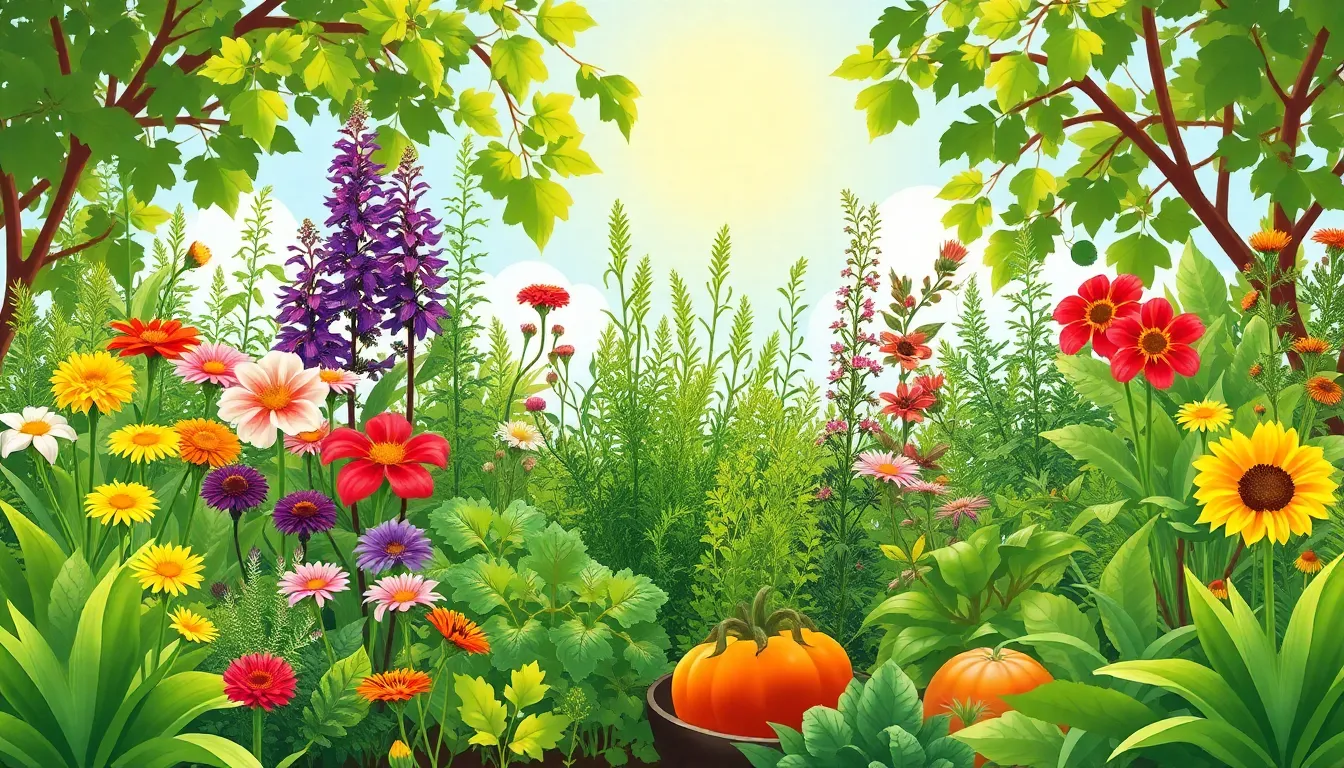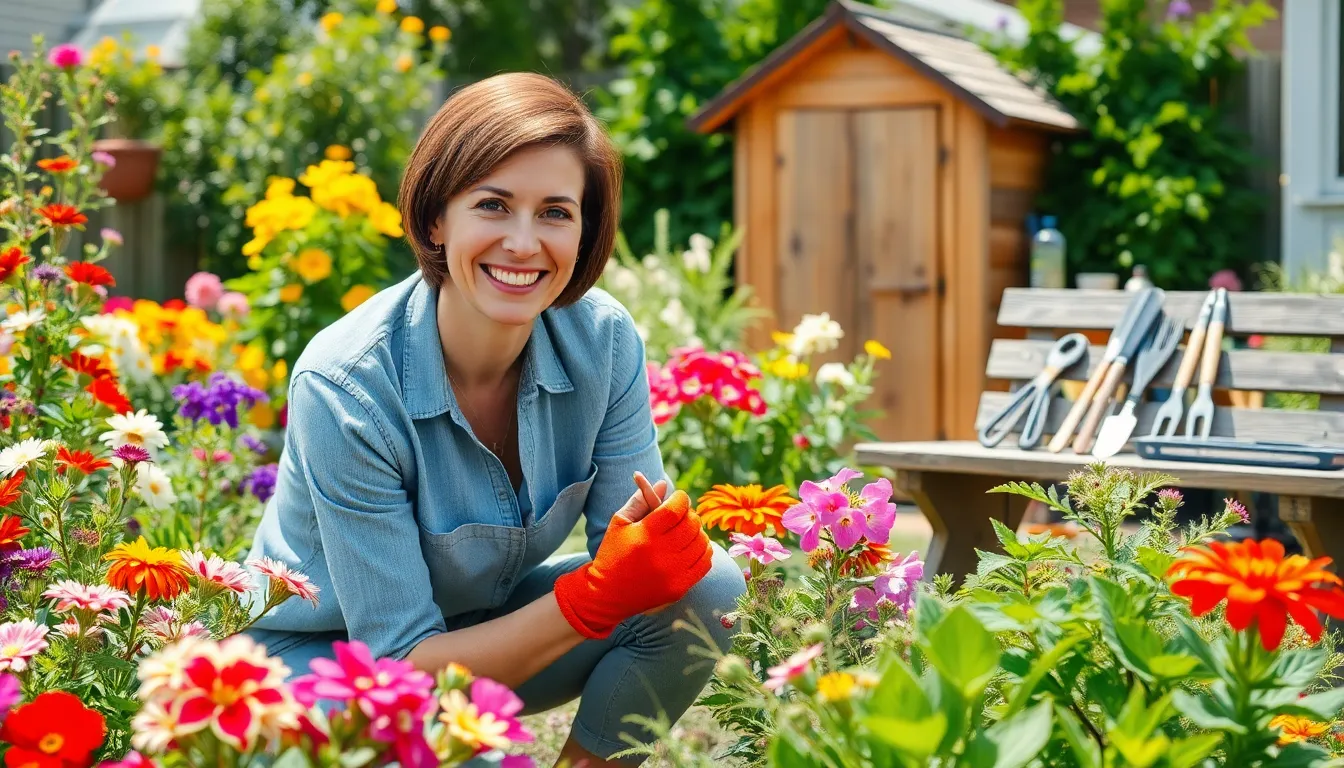Gardening might seem like a daunting task reserved for those with green thumbs and endless patience, but it’s time to dig up that misconception. With a little guidance, anyone can transform their backyard into a flourishing oasis. Imagine stepping outside to a vibrant garden bursting with color and life—who wouldn’t want that?
Beginners Guide to Gardening
Gardening begins with understanding fundamental elements. By grasping soil types and gathering essential tools, anyone can cultivate a thriving garden.
Understanding Soil Types
Soil types significantly influence plant growth. Clay soil retains moisture but drains poorly. Sandy soil drains quickly but may not hold nutrients. Loamy soil combines the benefits of both, offering good drainage and fertility. Assessing soil drainage and texture through a simple jar test helps determine the best plants for specific conditions. Organic matter improves soil quality, enhancing nutrient availability.
Essential Tools for Beginners
Beginners should start with a few key tools to simplify gardening tasks. Hand trowels assist in digging and planting. Pruners, beneficial for trimming and shaping plants, enhance growth. A sturdy garden fork helps aerate soil, improving root health. Gloves protect hands from thorns and soil irritation. Watering cans or hoses deliver necessary hydration. Choosing quality tools ensures longevity and effectiveness in maintaining a beautiful garden.
Choosing Plants for Your Garden

Selecting the right plants for your garden is essential for creating a thriving space. Consider several factors, including seasonal options and the choice between native and non-native plants.
Seasonal Plant Selection
Gardening varies with the seasons. Spring offers vibrant flowers and herbs, while summer allows for vegetables like tomatoes and peppers. Fall provides a chance to plant perennials that bloom in the coming years. Winter management strategies, such as utilizing indoor planting, can keep your green thumb active. Understanding your local climate can help you choose the right plants that thrive throughout the year. Use a gardening calendar to track ideal planting times for different species in your area.
Native vs. Non-Native Plants
Native plants suit local climates well. They typically require less water and attract beneficial pollinators such as bees and butterflies. These plants have adapted to local environmental conditions over time, ensuring they flourish without excessive care. Non-native plants, while often vibrant and attractive, may require more resources. They sometimes struggle to adapt, potentially becoming invasive, which disrupts local ecosystems. Always research available options to weigh the benefits of each type, ensuring a sustainable garden that supports local biodiversity.
Garden Planning and Design
Effective garden planning and design create a functional and aesthetically pleasing space. Thoughtful layout considers available space and personal preferences.
Layout Ideas for Small Spaces
Vertical gardening maximizes limited areas by utilizing walls and trellises for climbing plants. Container gardening offers flexibility, allowing individuals to arrange pots on patios or balconies. Raised beds improve accessibility, optimizing soil quality while minimizing weeds. Pathways and stepping stones can define sections of the garden, preventing soil compaction and providing access. Creative use of colors, such as bright flowers against green foliage, adds vibrancy to the small area. Utilizing low-maintenance plants reduces upkeep, enabling enjoyment without overwhelming efforts.
Companion Planting Techniques
Companion planting enhances growth through strategic pairings between different plants. Marigolds deter pests while attracting beneficial insects, improving other plants’ health. Basil planted near tomatoes boosts flavor and repels harmful insects. Likewise, beans add nitrogen to the soil, benefiting corn and squash when grown nearby. Additionally, planting garlic can help deter aphids and other pests. This technique capitalizes on natural relationships between plants, leading to healthier crops and maximizing space efficiency. Proper research and planning can ensure successful pairings for optimal gardening results.
Plant Care and Maintenance
Plant care and maintenance involves regular attention to ensure healthy growth. Proper practices lead to a vibrant garden.
Watering Techniques
Watering techniques vary based on plant needs. Consistent moisture helps plants thrive, while overwatering can lead to root rot. Early morning is the best time for watering as it reduces evaporation. Some gardeners suggest a deep soak once a week instead of shallow daily watering to encourage root growth. Drip irrigation systems provide targeted hydration and save water. Checking soil moisture levels prevents unnecessary watering and promotes healthy plants. Container plants often require more frequent watering due to quick soil drying. Adhering to these watering practices enhances overall garden health.
Pest Management Strategies
Pest management strategies play a crucial role in protecting plant health. Regular inspections help identify issues before they escalate. Introducing beneficial insects like ladybugs can naturally control pest populations. Organic solutions, such as neem oil, deter pests without harming plants. Crop rotation and companion planting can reduce pest attraction to specific plants. Maintaining garden cleanliness by removing debris eliminates potential pest habitats. Setting traps or barriers helps keep unwanted visitors away. By employing these strategies, a gardener boosts resilience against pests while ensuring a flourishing garden.
Harvesting and Enjoying Your Garden
Harvesting marks the rewarding culmination of gardening efforts. Timing plays a crucial role; most fruits and vegetables taste best when picked at their peak ripeness. Regular observation is essential for determining the right moment, as overripe produce can lead to loss of flavor and quality. Gentle handling is key during the harvest; using sharp, clean tools prevents damage to plants and reduces the risk of disease. Enjoying the fruits of labor enhances the overall gardening experience, and sharing the bounty with friends and family fosters a sense of community.
Best Practices for Harvesting
Gather equipment beforehand, as tools like shears or scissors streamline the process. Inspect plants carefully to identify mature produce, ensuring it’s ready for collection. Aim to pick early in the morning or late afternoon when temperatures are cooler to preserve freshness. Consider avoiding excessive plucking from single plants, allowing continued growth for future harvests. Storing harvested produce properly maximizes shelf life; keep leafy greens in the refrigerator and root vegetables in a cool, dark place. Following these practices promotes a successful harvesting experience.
Cooking with Homegrown Produce
Cooking with homegrown produce brings unique flavors to dishes. First, consider using fresh herbs as seasoning to elevate meals; basil, parsley, and cilantro enhance various cuisines. Tomatoes can be transformed into sauces or salads; their taste rivals store-bought varieties. Hearty vegetables like zucchini and peppers work well when grilled or roasted, offering a delicious taste of summer in any season. Utilize seasonal produce to inspire creative recipes; this practice encourages exploration and expands culinary skills. Enjoying meals made from garden bounty fosters appreciation for gardening, creating a fulfilling cycle from soil to kitchen.
Conclusion
Gardening opens up a world of creativity and satisfaction for anyone willing to try. By understanding the basics of soil types and essential tools beginners can embark on a fulfilling journey. Choosing the right plants and employing effective strategies for maintenance will lead to a thriving garden that brings joy and beauty to any space.
As they cultivate their gardens they’ll discover the rewards of patience and care. Harvesting fresh produce or enjoying a colorful bloom can be immensely gratifying. With the right knowledge and a little practice anyone can transform their backyard into a vibrant oasis that supports local ecosystems and enhances their lifestyle. Embrace the adventure of gardening and watch as it flourishes.

